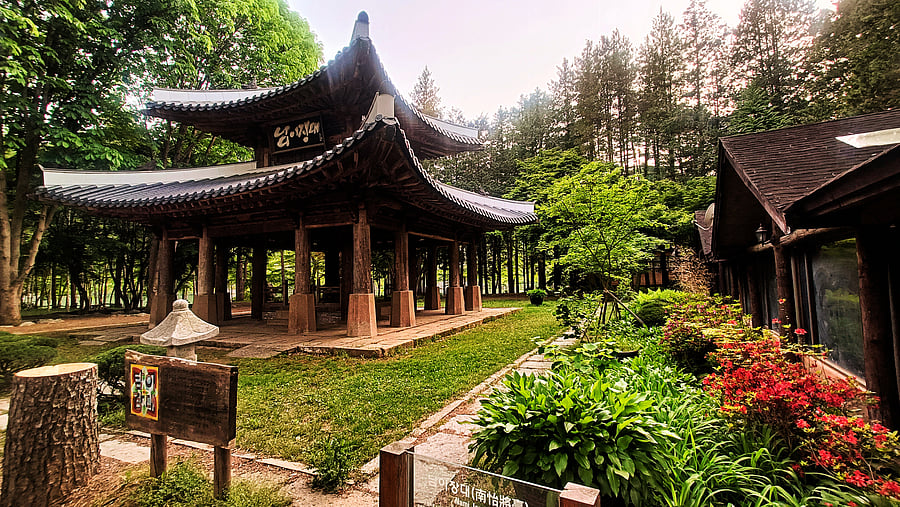
Nami Jangdae is the restored version of a building known as 'Seojangda', a Unesco Heritage site that was destroyed by a fire in 2006.
Credit: Rashmi Vasudeva
Nami Island is a love story. Yes, many popular K-dramas have been shot on this compact, picturesque island, but that’s not why. Nami is the tale of a former banker who lost his heart to a half-moon island floating in the middle of the blue-grey waters of Cheongpyeong Lake in South Korea.
In its soil is the toil and the passion of a man who was determined to convert a sandy piece of land where nothing grew into a green paradise. Nami was also the muse of a renowned graphic designer. This wasteland fired his imagination and inspired him to transform it into a buzzing cultural hub: a green retreat where every discarded item, from broken soju bottles to burnt pines and empty makeup tubs, was used to beautify the land, gently and thoughtfully. And Nami is a love story because after having turned its back for years, nature, in all its fierce glory, returned to reclaim her as its own.
That man was Chairman Minn Byeong-do (1916–2006), who stepped down as the head of the Bank of Korea and used his retirement pay to buy the island that had been flooded so often that the soil had lost its ability to sustain life. Undeterred, he planted trees. They died on him. He planted again. And yet again. At last, slowly, Korean pines, birch, fir, cherry trees and metasequoias all began to take root.
Around the same time, he invited author-illustrator-graphic designer Kang Woo-hyon, considered one of South Korea’s most innovative artists, to redesign the island. Kang writes in his book on Nami Island that in his head, he “drew a picture of the island busy from dawn to dusk” with people waiting in line to cross over on the ferry to attend its cultural festivals. And so he set to work.
He believed that to revitalise the island, he had to first “revitalise nature.” Tree-lined pathways were created, as were little thickets. Animals were let free. Ostriches roamed around, peacocks squealed to each other, fat rabbits hopped about, and red squirrels played hide-and-seek. Soon, flowers bloomed, trees grew, birds came — and the visitors too. In droves.
Kang calls this ‘made nature’: “From the earth of the pathways to each and every tree, nothing was originally found there in nature… much sweat went into creating this ‘made nature’ — the nature of Nami is the nature of human labour,” he writes. What emerged was a delicate balance — art, nature, and vision blending to create an immersive retreat for locals and visitors alike.
It has been two decades since the island’s extraordinary journey began. Nambook 2025 — the Nami Island International Children’s Book Festival — completed its 12th edition in May. This year, the guest of honour was India, and that was what took me to this idyllic getaway, around an hour’s journey from the capital, Seoul. Although South Korea is now firmly on the Indian tourist’s must-visit list, most usually stick to the Seoul–Busan–Jeju Island route. But a little detour to this hidden gem, especially during the biennial spring festival, is well worth the effort.
Spread over 4,60,000 square metres, the island is dotted with art galleries and book centres. It also boasts an open stage and a performance hall where live concerts are held during the festival. The ‘Children’s Book Festival’ is a bit of a misnomer, though; while children’s books remain the primary focus, Nambook offers much more to the visitor — from art experiences to masterclasses in crafting, to DIY workshops and wellness activities, not to forget authentic Korean fare from the many cafés and restaurants that keep the island humming, just as how Kang imagined, years ago.
Since the theme this year was India, you could step into the Song Museum to spend some alone time with Tagore’s lyricism or walk into ‘The Land of Myths’ at the Pyeonghwarang Gallery, where traditional works of Indian folk art and sculpture were on display from the private collection of art historian Dr Jin-hee, accumulated over years of curatorial expertise.
At the Jodhpur Garden, a little further away, you could immerse yourself in the splendours of the Mehrangarh Fort and finish your walk by learning about silkscreen printing with the Chennai-based Tara Books. One of the many things that makes your stay in Nami so serene is that no vehicles are allowed within the island’s perimeter. And so, you walk everywhere. And walk I did. Aimlessly. With the express purpose of getting lost. And while I was indeed lost, I stumbled into a grove ablaze with the red leaves of the Japanese maple, met a peacock that gave me the royal ignore and strolled into a café, watched a silly magpie jump up and down a stone bench for no apparent reason, frightened a pair of mallard ducks enough for them to hurriedly splash into the nearest pond, blew dandelion wishes, ran across a green meadow in the drizzling rain, barely escaped being stung by a swarm of hornets and gazed in wonderment at two ostriches that were sitting so plump and so still that I half-thought they were statues. All the things I never get to do amidst the daily grind of Bengaluru. All the seemingly ordinary stuff that got me smitten. Now, we too have a love story — Nami and I.
Quick facts
How to go: You can take a train from Gapyeong Station in Seoul, or hire a taxi to the Nami Island Ferry Dock. Adventurers can zipline into the island directly from the dock.
Don’t miss: Metasequoia Lane, Gingko Tree Lane, Statue of Winter Sonata, and riverside walks.
Best time to visit: Spring for cherry blossoms, winter for a snowy wonderland.
(The writer was in South Korea recently on the invitation of Nami Island Arts & Education, Inc.)